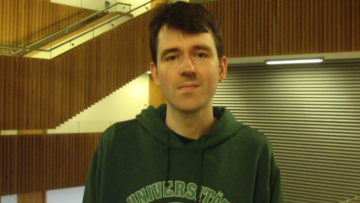Neural Controlled Differential Equations for Online Prediction Tasks.
Morrill, J
Kidger, P
Yang, L
Lyons, T
CoRR
volume abs/2106.11028
(2021)
Modelling the influence of naturally acquired immunity from subclinical infection on outbreak dynamics and persistence of rabies in domestic dogs
Gold, S
Donnelly, C
Woodroffe, R
Nouvellet, P
PLoS Neglected Tropical Diseases
volume 15
issue 7
(20 Jul 2021)
A particle method for solving Fredholm equations of the first kind
Crucinio, F
Doucet, A
Johansen, A
Journal of the American Statistical Association
volume 118
issue 542
937-947
(09 Sep 2021)
Aggregation and Control of a Heterogeneous Population of Solar Panels Over the Grid Frequency
Peruffo, A
Guiu, E
Panciatici, P
Abate, A
IEEE Transactions on Control Systems Technology
volume 29
issue 4
1420-1436
(01 Jul 2021)
The central sphere of an ALE space
Hitchin, N
Quarterly Journal of Mathematics
volume 72
issue 1-2
253-276
(15 Jan 2021)
Oxford Mathematician Connor Behan discusses the ways in which a free quantum field can be coupled to a spatial boundary. His recent work with Lorenzo di Pietro, Edoardo Lauria and Balt van Rees sheds light on this question using the non-perturbative bootstrap technique.
Government responses and COVID-19 deaths: Global evidence across multiple pandemic waves
Hale, T
Angrist, N
Hale, A
Kira, B
Majumdar, S
Petherick, A
Phillips, T
Sridhar, D
Thompson, R
Webster, S
Zhang, Y
PLOS ONE
volume 16
issue 7
(09 Jul 2021)
Spatial and temporal invasion dynamics of the 2014–2017 Zika and chikungunya epidemics in Colombia
Charniga, K
Cucunubá, Z
Mercado, M
Prieto, F
Ospina, M
Nouvellet, P
Donnelly, C
PLOS Computational Biology
volume 17
issue 7
e1009174
(02 Jul 2021)
Average beta burst duration profiles provide a signature of dynamical changes between the ON and OFF medication states in Parkinson’s disease
Duchet, B
Ghezzi, F
Weerasinghe, G
Tinkhauser, G
Kühn, A
Brown, P
Bick, C
Bogacz, R
PLOS Computational Biology
volume 17
issue 7
(07 Jul 2021)


